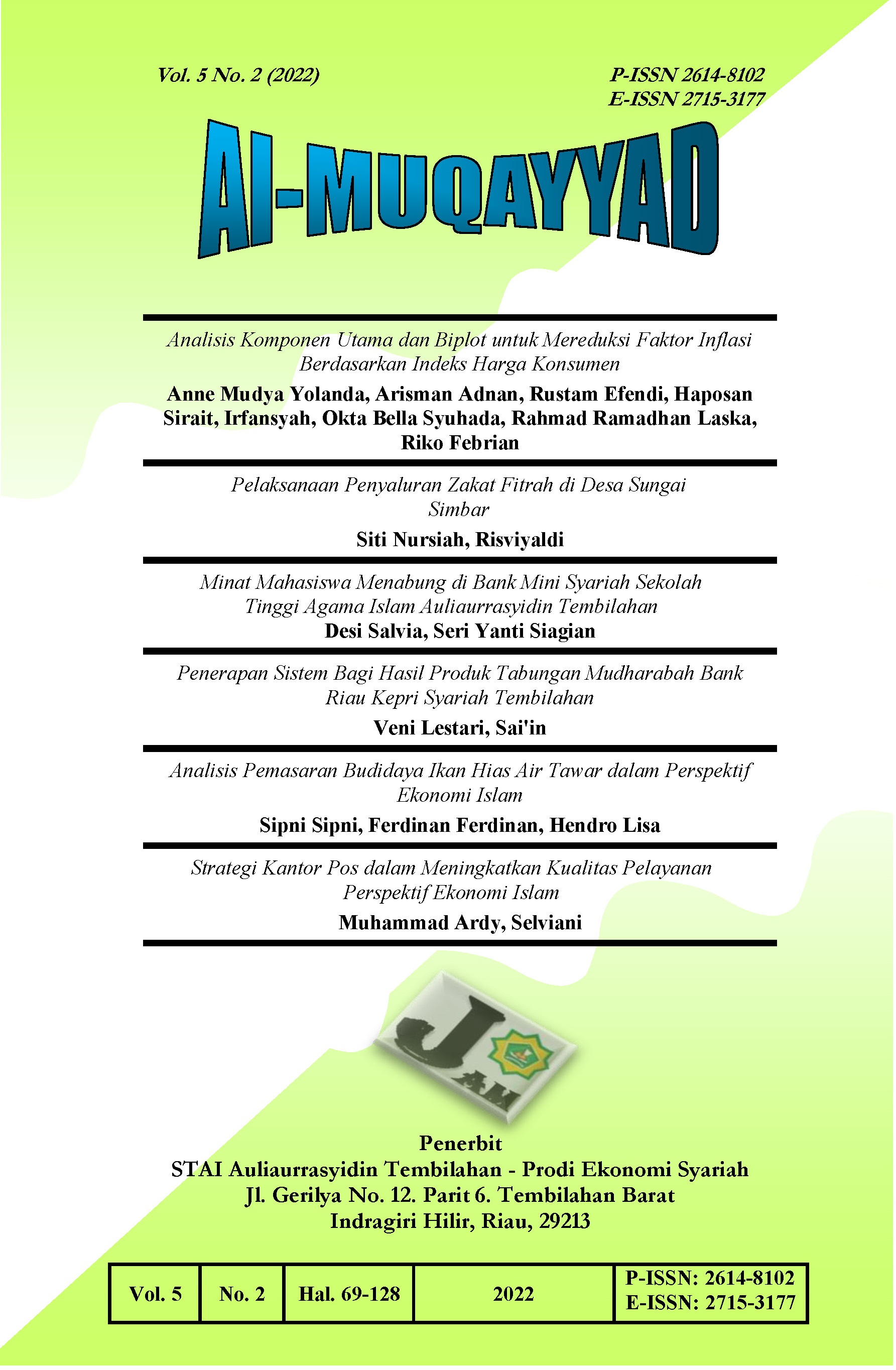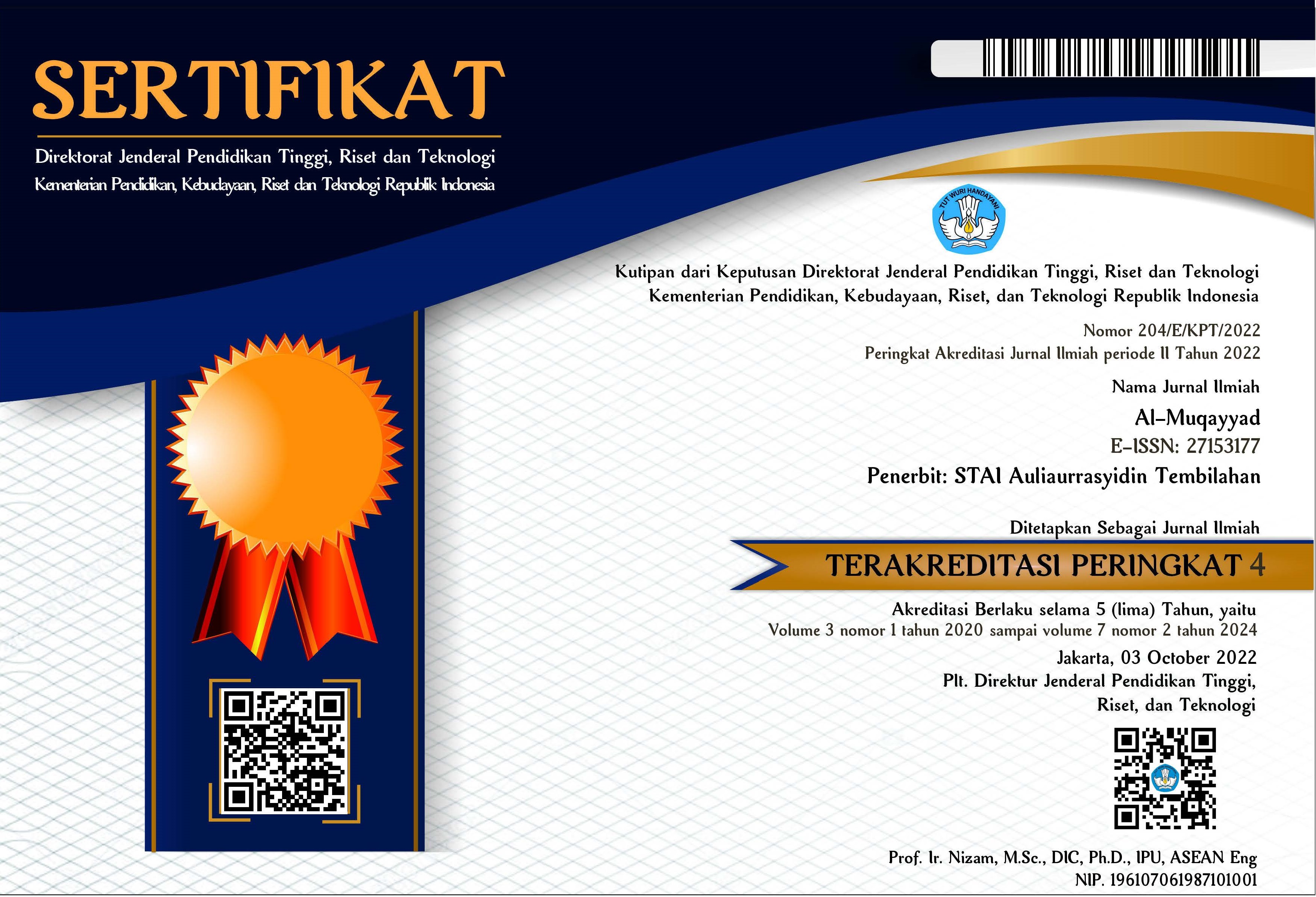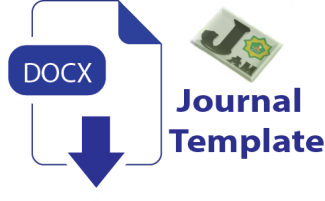Pelaksanaan Penyaluran Zakat Fitrah di Desa Sungai Simbar
DOI:
https://doi.org/10.46963/jam.v5i2.795Keywords:
Zakat Fitrah, Implementation, Distribution, MustahikAbstract
This study aims to determine the implementation of the distribution of zakat fitrah in Parit 05 Utara Sungai Simbar Village, Kateman District, Indragiri Hilir Regency. This type of research is field research with a qualitative descriptive method. Sampling using the Slovin formula with purposive sampling technique. With data collection methods using interviews, observation and documentation. The results of the study show that the distribution of zakat fitrah is carried out directly by all people who issue zakat fitrah. Zakat fitrah is handed over directly by muzakki to mustahik zakat. According to Islamic law, the implementation of the distribution of zakat fitrah is not entirely correct, because there are still muzakki who hand over their zakat fitrah to people who are not from the 8 asnaf zakat groups. In addition, mustahik zakat fitrah there get an inappropriate portion of zakat fitrah, namely poor mustahik receive less zakat fitrah than mustahik fisabilillah, even though Islam prioritizes the distribution of zakat fitrah to the needy and poor mustahik than other mustahik.
Downloads
References
Al-Zuhayly, Wahbah. (2008). Zakat Kajian Berbagai Madzab. Bandung: PT Remaja Rosdakarya
Andriawati, Rini. (2019).Penyaluran Zakat Fitrah menurut Posisi Fiqh di Desa Simpang Babeko Kabupaten Bungo.Skripsi: Fakultas Syari’ah Universitas Islam Negeri Sultan Thaha Saifuddin.
Baghur, Muhammad. (1999). Al-Habsy, Fiqih Prakti. Bandung: Mizan
Bungin, Burhan. (2010). Metodologi Penelitian Kuantitatif. Jakarta: Prenada Media Grup
Ghofur Anshori, Abdul. (2006). Hukum dan Pemberdayaan Zakat, Upaya Sinergis Wajib Zakat dan Pajak di Indonesia. Yogyakarta: Pilar media
Hafidhuddin, Didin. (2008). Zakat dalam Perekonomian Modern. Depok: Gema Insani
Hardani, dkk. (2010). Metode Penelitian Kualitatif & Kuantitatif. Yogyakarta: Cv. Pustaka Ilmu Group
Hasbyallah. (2017).Fiqh dan Usul Fiqh: Metode Istinbath dan Istidlal. Bandung: PT Remaja Rosdakarya.
J. Moleong, Lexy. (2015). Metode Penelitian Kualitatif. Bandung: PT Remaja Rosdakarya.
Kementerian Agama Republik Indonesia. (2013). Panduan Zakat Praktis. Jakarta: Kementerian Agama.
Mas’ud, Ibnu, Abidin Zainal. (2007). Edisi Lengkap Fiqih Madzhab Syafi’I Buku I: Ibadah. Bandung: CV Pustaka Setia.
Mujahidin, Akhmad. (2017).Ekonomi Islam Sejarah, Konsep, Instrumen, Negara, dan Pasar. Depok: PT Rajagrafindo Persada.
Mursyidi. (2011). Akuntansi Zakat Kontemporer. Bandung: PT Remaja Rosdakarya
Musfiqon, M. (2012). Metodologi Penelitian Pendidikan.Jakarta: Prestasi Pustakaraya.
Putri Wulan, Vony. (2019). Implementasi Penyaluran Zakat Fitraholeh Amil di Kelurahan Banjarsari Kecamatan Metro Utara Kota Metro. Skripsi: Fakultas Ekonomi dan Bisnis Islam Institut Agama Islam Negeri IAIN Metro
Prayoga, Akris. (2015). Tinjauan Hukum Islam Terhadapa Penyaluran Zakat Fitrah Untuk Pembangunan Masjid At-taqwa di Desa Tajungsari Kecamatan Tlogowungo Kabupaten Pati. Skripsi: Fakultas Syari’ah dan Hukum Universitas Islam Negeri Walisongo Semarang.
Qardawi, Yusuf. (1999). Hukum Zakat. Jakarta: PT Pustaka Litera Antarusa.
Rasjid, Sulaiman. (2009). Fiqh Islam. Bandung: Sinar Baru Algensindo.
Satori, Djam’an, Aan Komariah. (2017). metodologi penelitian kualitatif, Bandung: Alfabeta.
Sugiyono. (2017). Metode Peneitian Manajemen. Bandung: Alfabeta
Sugiyono. (2016). Metode Penelitian Kuantitatif, kualitatif, dan R&D. Bandung: Alfabeta.
Sugiyono. (2015). Memahami Penelitian Kuantitatif. Bandung: Alfabeta.
Thaha, Khat Ustman. (2013). ALWASIM: Alqur’an Tajwid Kode Transliterasi Per Kata Terjemah Per Kata. Bekasi: Cipta Bagus Segara.
Downloads
Published
Issue
Section
License
Copyright (c) 2022 Siti Nursiah, Risviyaldi Risviyaldi

This work is licensed under a Creative Commons Attribution-ShareAlike 4.0 International License.
Authors who publish with this journal agree to the following terms:
1. Copyright on any article is retained by the author(s).
2. The author grants the journal, right of first publication with the work simultaneously licensed under a Creative Commons Attribution shareAlike 4.0 International License that allows others to share the work with an acknowledgment of the work’s authorship and initial publication in this journal.
3. Authors are able to enter into separate, additional contractual arrangements for the non-exclusive distribution of the journal’s published version of the work (e.g., post it to an institutional repository or publish it in a book), with an acknowledgment of its initial publication in this journal.
4. Authors are permitted and encouraged to post their work online (e.g., in institutional repositories or on their website) prior to and during the submission process, as it can lead to productive exchanges, as well as earlier and greater citation of published work.
5. The article and any associated published material is distributed under the Creative Commons Attribution-ShareAlike 4.0 International License





2.png)



